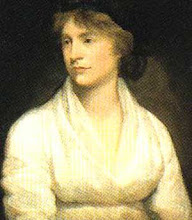17 October 2008
A Reader–Response Criticism: Meant to be Appreciated (Southern Literature)
Today, when the temperature changes and the season becomes anew, it is easy to remember living in a rural Georgia community. What I do recall is that although the area lacked an abundance of extracurricular facilities for its youth, it was rich in other things—tradition, heritage and family—and stagnant but as colorful as an old hand-worked quilt in any home, even today. These quilts can be found in every home. I have several in my possession as well. Some were given to me as gifts for various occasions from my grandmothers, my aunts, my mother and the church “sisters” from our community. In my family, the trade of quilting has been passed down for generations.
As stated in the analysis “In Spite of It All: A Reading of Alice Walker’s ‘Everyday Use’” in the African American Review, Sam Whitsitt quoted Barbara T. Christian’s assertion that “the metaphor of quilting to represent the creative legacy that African Americans have inherited from their maternal ancestors” (443). Alice Walker has been instrumental in analyzing the value of the quilt in the black experience. Most black experiences are unique yet similar, for instance many share life experiences. I remember from my parent’s backyard, I could see a family pond that was surrounded by the homes of my relatives. It still exists today as an 84 acre plot of houses owned and operated, with small gardens on the side or in the back, by family members. I shared that experience with two siblings and sixty three cousins.
Characterized by personal development, social elevation and cultural awareness, Alice Walker presented a distinct analysis of these concepts in the short story “Everyday Use.” Being caught in the middle of two ideologies were three family members, Mrs. Johnson, Maggie and Dee/Wangero. The vastness of the short story can be analyzed through the reader-response approach. Recognizing that different readers will have different responses to the work of literature at variable life stages and life experiences that are specific to the reader’s evaluation of the text. The characteristics of personal development, social elevation and cultural awareness of the three main characters, Mrs. Johnson, Maggie and Dee/Wangero will be discussed and examined.
This year, during my re-entrance into the collegiate setting in English studies, I, a young African-American woman from the South—a second career advent—was delighted to choose a career path beyond that of Respiratory Therapy. I had truly believed my calling to be a clinician but I had not truly appreciated my uniqueness and love of literature and spoken word. With the enthusiasm of a recent student, I am challenging my beliefs and reconsidering the understandings of my Southern history and traditions, to “revise [my] notions of what constitutes [a] sense of place, political agenda, race and class" (630). I was born and reared in Roberta, Georgia, which is approximately a forty-five minute drive from Eatonton, Georgia, where Alice Walker was born and reared (556). As a child, my mother loved to read poems written by Walker, as she thought television to be the death of us.
While reading Steven Mailloux’s Reading in Critical Theory, I realized each reader responds differently to the text. My reading of Alice Walker’s short story “Everyday Use” and my continuing evaluation of my childhood and my love of quilting has lead me to analyze my life and its place as it relates to the short story (1149). I began quilting around the age of ten, during the summer when school was not in session. My aunt never learned to knit or crochet, but she was a phenomenal quilter. Aunt Mattie Pearl Blasingame took a special interest in me. A quiet woman of menial means, Aunt Mattie Pearl sold quilts to aid in the financial status of her home. She was actually my great-great aunt but those specific distinctions were not routinely made in my family, then or now. She was not well educated and could read very little, but she had memorized passages of Scripture and could tell virtually every major story in the Holy Bible.
Financially and educationally deprived, Aunt Mattie Pearl was emotionally depressed as well. Creating meaning and experience to the text to be analyzed, her husband, Uncle Josephus, was a farmer and they had eleven children whom did not visit very often. Uncle Joe was a bit of a tyrant and suffered many of the emotional ills of black men of his day. He needed to control something; his obedient and submissive wife was the perfect victim. To further aid in processing the text, Aunt Mattie Pearl’s grand-daughter, Laura, commissioned her for quilts and obtained orders from everywhere. Laura was a recent graduate from Georgia College and State University in Milledgeville, Georgia. Not knowing the worth of the quilts, Aunt Mattie Pearl sold the quilts for $25.00 a piece. She was ecstatic and reveled in the financial gain, but her bruised hands told another story.
With her new found wealth, her life began to change. As a child, I could not understand why that part of the family was so odd. My mother would tell us that it was not Aunt Mattie Pearl, but “it was that crazy Uncle Joe.” She surmised he did not know any better and did not want any better. He alienated his family from the community. My father and uncles would go down and take food or offer to do handy man jobs around the house. Uncle Joe was old and unable to do any hard physical labor—the sight of their home told the story all too well—but he would refuse and would politely say “if I need ya, I’ll call ya”—they did not have a telephone. Constantly working to provide financial means for her family, Aunt Mattie Pearl would make three to four quilts a week. As soon as they were made, she would sell them. Aunt Mattie Pearl was always positive despite her circumstances. She always sang as she quilted. She was proud of her accomplishments and for the first time people commented on her wonderful smile. Why not rest, I once asked. “When the Lord gives you a way out, take it,” she responded and busily began a new quilt.
These memories with Aunt Mattie Pearl forced me to analyze my views of Alice Walker’s short story, not to mention to examine my own position about culture and heritage. If Mrs. Johnson was the uneducated woman living in rural Georgia and the matriarch of her family, Aunt Mattie Pearl was the antitype (631). If Maggie, the stay at home daughter in the story, was the meek and devoted daughter, Laura was the antitype. And if Dee/Wangero was the culturally aware and educated daughter, I was the antitype.
Both Mrs. Johnson and Aunt Mattie Pearl were family matriarchs: Mrs. Johnson supported her family and worked hard, along with the Church, to send Dee “to Augusta to school” (559). Likewise Aunt Mattie Pearl would make quilts and give Laura “spending change” while she matriculated Georgia College and State University. Both women were uneducated and living in rural communities in substandard housing. Both women took on the overseer role for their families. And both knew the importance of an education, despite not being able to obtain one themselves. They were stout women who desired the best for their families.
Both Maggie and Laura were devoted “daughters” in the truest sense of the word: Maggie stayed around the home and aided her mother in cleaning the yard and other domestic duties. Likewise Laura cared for her grandmother and desired to aid her in financial stability by soliciting orders for her quilts. She did not seek to change her grandmother or teach her a new trade. Instead she embraced what her grandmother knew well and helped her to make it profitable. Both women took on supportive roles and aided the matriarchs of their respective families.
Also like Maggie, Laura showed a sense of true cultural enlightenment in her appreciation and respect for character. Both women accepted the matriarchs in their family as they were and did not attempt to change or mold them into something better or more than they were. They simply embraced the person, not flowery notions of what they should be. Maggie remembered the stories of her ancestors and could recall them at will. Maggie was in touch with her family history and was deeply rooted in her heritage.
Both Dee and I possessed a cultural awareness that has been aided through education. Like Dee I have chosen to embrace the characteristics of my ethnicity; we both expressed this with natural hair texture. As in Dee’s childhood, I loved the audience of the family as I read and re-read stories. My family members listened intently and surely must have felt some “tiredness” of it all. Education was important to my family and they are still are a driving force for me.
Like Dee, I also appreciate my cultural and ethnic identity; but unlike Dee, I do not reject my personal history or try to exploit its circumstances. Mailloux asserted a component of a “reader-response criticism actually attempts to define a critical “movement” and therefore helps establish and disseminate it as well” (1150).
This is further explained by Barbara Christian in the first paragraph of her introduction of “'Everyday Use’ by Alice Walker” that “the Black Power Movement and the Second Wave of the Feminist Movement [are] two social interventions that define the literary commitments…and shape[d] our viewpoints about the social commitment to higher education (308). After this time period, African Americans exhibited a social commitment to higher learning. Dee was out-of-touch in her willingness to cling to a culture that she had not direct ties. By taking on the new name Wangero, and denying her generational name Dee, she lost touch with the concept of heritage. Her birth name had meaning and significant but Dee was unable to conceptualize that fact.
In Walker’s story, Dee has returned only to obtain certain items that she deemed historically and culturally valuable. Prior to embracing her family, she thought it necessary to take pictures of her mother, a cow, and the shack in which they lived. Dee was on a mission of sorts in order to obtain and secure their historical wealth—their heritage.
The house similar to the one she reveled as it burned to the ground became an architectural masterpiece. The bench that represented poverty as a child was now a piece of art. The irony and paradoxical duality of these occurrences brought to life her [Dee’s] out-of-touch personality. Mrs. Johnson noted the way Dee and Hakim-a-barber, her companion, had a conversation that was above her comprehension with their eyes.
Like Dee’s appreciation of the quilts, I display special quilts on my walls at my home. And occasionally on a quiet evening, I simply stare at them, appreciate them, and find a sense of peace. Unlike Dee/Wangero whose motives were a paradoxical irony—something she detested, she also wanted to preserve; something that was beneath her was something of supreme value. I believe Dee/Wangero was not sinister or evil but acted out of her need for preservation. She saw the value of her heritage and the main motive was of good origin--preservation of history. She realized that a remnant of a deep and rich past was bound in the quilts.
I am similarly interested in preserving the history of my family through restoration of family photographs and preservation of quilts and other items, for example, the copy of my great-grandparents wedding photo frame. Many critics have faulted Dee/Wangero for being out of touch with the needs of her family and attempting to exploit their ignorance to material value. I almost faulted her as well. Although I can identify with her efforts, I do not identify with her methods.
It had been years since I read the story of “Everyday Use” and now I have a clearer understanding and a newer appreciation for things of the past. These things matter and are a part of my culture. I recognize that the story of “Everyday Use” is a strong testament to my own history, “that this paper, if quilt-like in its narrative”, is a paradoxical and physical metaphor for the narrative and is designed to be displayed in our hearts, designed to be displayed on our walls and designed to be used every day, simultaneously (634).
Works Cited
Christian, Barbara T. “’Everyday Use’ by Alice Walker.” African American Review. 30.2 (1996): 308-309. JSTOR.16 October 2007 .
Mailloux, Steven. “Reader-Response Criticism: From Formalism to Post-Structuralism” Comparative Literature. 96.5 (1981): 1149-1159. JSTOR.16 October 2007 <>.
Torsney, Cheryl B. “Everyday Use: My Sojourn at Parchman Farm.” Literature and Its Writers: A Compact Introduction to Fiction, Poetry, and Drama. 4th ed. Ed. Ann Charters and Samuel Charters. Boston: Bedford/St. Martin’s, 2007. 630-634.
Whitsitt, Sam. “In Spite of It All: A Reading of Alice Walker’s ‘Everyday Use.’” African American Review. 34.3 (2000): 443-459. JSTOR.16 October 2007 < http://links.jstor.org/search>.
Walker, Alice. “Everyday Use.” Literature and Its Writers: A Compact Introduction to Fiction, Poetry, and Drama. 4th ed. Ed. Ann Charters and Samuel Charters. Boston: Bedford/St. Martin’s, 2007. 556-564.
Subscribe to:
Post Comments (Atom)









3 comments:
I am very impressed with your writing. You have a great style of conveying your thoughts and I am impressed with your knowledge--you are obviously very well read and quite educated!
You may want to break up some of your material into two or more entries. That is my only complaint, I found myself overwhelmed by the many paragraphs even though I found the material interesting. So many of us are limited on time these days so I feel that more frequent entries in smaller amounts would be more effective.
Alyssa Hanzi
Thank you for the feedback. Have a great day.
شركة تنظيف مكيفات بالدمام
Post a Comment